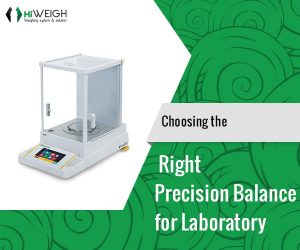There are various types of precision balances available on the market, and it makes sense that you buy the best choice available. It is essential to consider certain factors when making a decision to select the right precision balance for laboratory. You need to know the application where the balance will be used, the accuracy required, the maximum capacity, the load cell protection, the ROI, if it is going to be Auto calibration or Manual calibration, the service warranty provided, the track record of the brand, etc.
It is important that the measuring scale displays the exact perusing estimations. A computerized or digital measuring scale uses the compel sensors to measure the heap of physical entity. Here we discuss the standard features and applications for Precision Balances, Moisture Analyzers, Analytical balances, Portable balances, and Top loading balances.
Analytical Balance
An analytical balance is typically used for differential weighing, formulation weighing, density measurements, interval weighing when logged in to a PC, pipette calibration, density weighting, sample management, and other types of requirements in a laboratory that need analytic weighing. This type of balance is capable of measuring small mass in the range of 0.01 mg and 1 mg.
Precision Balance
Precision balances, also referred to as high precision balances, are known as electronic balances and are usually used in the laboratory. These balances have a readability of 0.1g, 0.01g and 0.001g.
Moisture Analysers
Moisture Analysers uses infrared or halogen heat sources to measure moisture or solid contents. This type of instrument provides fast and accurate results and are easy to operate. Moisture Analysers find wide applications in pharmaceuticals, soils, grains, chemicals, sludge, and much more.
Micro-balance
Micro-balances are usually used as standalone instruments in the laboratory, though they are also used along with other instruments, like thermogravimetry, sorption/desorption systems as well as surface property instruments. This type of balances has an accuracy range between 1µg (0.000001 g) and 0.01 mg (0.00001 g). Micro-balances find wide applications in stent weighing, pipette calibration, particulate matter weighing, analysis of pesticides, elemental analysis of glass, and other critical micro-weighing requirements in the laboratory.
Ultra-microbalance
Ultra-microbalance finds applications in the measurement of smallest samples with high resolution of up to 0.0001 mg.
Top Loading Balance
Top loading balance remains the standard type of weight measuring scales found in laboratory use. There are various types of these balances available depending on the size and weight capacities up to 30,000g. This type of balances is usually required to weigh solid materials when the minimum required precision is 0.1 g.
Portable Balance
Portable balances are often found in field sampling use. These balances are usually simple, easy to use, quick, lightweight and compact. This type of scales run either with battery or with AC connection to measure and provide results.
Choosing the right precision balance is an investment worth made. The use of the right instrument for a task not only brings precision and accuracy to the measurement but also improves efficiency and reduce waste and in the long run, as well as saves money in the long run.
HiWEIGH Weighing System & Solution is providing high accuracy precision balance for laboratory. To learn more about the different types of weighing balances and scales on sale, contact us by calling +86-21-58050298 (Ext. 601/602/607). You can also send us a mail at info@hiweigh.com.

